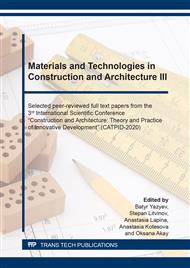[1]
V.S. Dorofeev, V.N. Vyrovoi, Technological damage to building materials and structures, Odessa, (1998).
Google Scholar
[2]
L. Opoczky, F.D. Tamas, Multicomponent composite cements, New Delhi, (2002).
Google Scholar
[3]
N.F. Afanas'ev, M.K. Tseluiko, Concrete and mortar additives, Kiev, (1989).
Google Scholar
[4]
I.M. Krasnyi, On the mechanism of increasing the strength of concrete with the introduction of microfiller, Concrete and Reinforced Concrete. 5 (1987) 10-11.
Google Scholar
[5]
A.K. Chatterjee, Special cements: in Structure and Performance of Cements, in: J. Bensted and P. Barnes (Eds.), Second ed, Spon Press, London, New York, 2002, pp.186-237.
Google Scholar
[6]
S.S. Kaprielov, General patterns of formation of the structure of cement stone and concrete with the addition of ultrafine materials, Concrete and Reinforced Concrete. 4 (1995) 16-20.
Google Scholar
[7]
Yu.M. Bazhenov, Modern concrete technology, Concrete Technology. 6 (2005) 6-8.
Google Scholar
[8]
P. Pipilikaki, M. Katsioti, Study of the hydration process of quaternary blended cements and durability of the produced mortars and concretes, Construction and Building Materials. 23 (2009) 2246–2250.
DOI: 10.1016/j.conbuildmat.2008.11.015
Google Scholar
[9]
A.G. Ol'ginskii, Features of contact formation in cement concretes with mineral microfiller, Bulletin of the Donbass National Academy of Civil Engineering and Architecture. 1 (43) (2004) 134-140.
Google Scholar
[10]
T.K. Erdem, Use of binary and ternary blends in high strength concrete, Tahir Kemal Erdem, Önder Kirca, Constr. Build. Mater. 22 (7) (2008) 1477-1483.
DOI: 10.1016/j.conbuildmat.2007.03.026
Google Scholar
[11]
V.V. Babkov, S.M. Kapitonov, I.V. Onishchenko and A.F. Polak, The effect of microfiller in cement concrete technology and its nature, Basic research and new technologies in building materials science, BTIBM, Belgorod. (1989) 54-55.
Google Scholar
[12]
J.-I. Escalante-Garcia, J.H. Sharp, The chemical composition and microstructure of hydration products in blended cements, Cement and Concrete Composites. 26 (8) (2004) 967-976.
DOI: 10.1016/j.cemconcomp.2004.02.036
Google Scholar
[13]
F. De Larrard, Ultrafine particles for making of very high strength concrete, Cem. Concr. Res. 19 (2) (1988) 161-172.
Google Scholar
[14]
J. Yang, A. Sliva, A. Banerjee, R.N. Dave, R. Pfeffer, Dry particle coating for improving the flowability of cohesive powders, Powder Technology. 158 (1-3) (2005) 21-33.
DOI: 10.1016/j.powtec.2005.04.032
Google Scholar
[15]
T. Iwasaki, M. Satoh, T. Ito, Determination of optimum operating conditions based on energy requirements for particle coating in a dry process, Powder Technology. 123 (2-3) (2002) 105-113.
DOI: 10.1016/s0032-5910(01)00439-9
Google Scholar
[16]
G. Thomas, Y. Ouabbas, P. Grosseau, Modeling the mean interaction forces between powder particles, Application to silica gel-magnesium stearate mixtures, Applied Surface Science. 255 (2009) 7500-7507.
DOI: 10.1016/j.apsusc.2009.03.099
Google Scholar
[17]
Y. Ouabbas, A. Chamayou, L. Galet, Surface modification of silica particles by dry coating: Characterization and powder ageing, Powder Technology. 190 (1-2) (2009) 200-209.
DOI: 10.1016/j.powtec.2008.04.092
Google Scholar
[18]
I. Tanaka, N. Suzuki, Y. Ono, M. Koishi, A comparison of the fluidity of spherical cement with that of broad cement and a study of the properties of fresh concrete using spherical cement, Cem. Concr. Res. 29 (4) (1999) 553-560.
DOI: 10.1016/s0008-8846(99)00013-7
Google Scholar
[19]
J. Hautanen, M. Kilpelainen, E.I. Kauppinen, Electrical agglomeration of aerosol particles in an alternating electric field, Aerosol Science and Technology. 22 (2) (1995) 181-189.
DOI: 10.1080/02786829408959739
Google Scholar
[20]
A.K. Khalyushev, S.A. Stel'makh, E.M. Shcherban', A.K. Sysoev, Computer simulation of the electrostatic field of corona discharge with a matrix of corona electrodes, AIP Conference Proceedings. 2188 (2019) 040015.
DOI: 10.1063/1.5138424
Google Scholar
[21]
E.I. Andrianov, Methods for determining the structural and mechanical characteristics of powder materials, Moscow, (1982).
Google Scholar
[22]
A.D. Zimon, E.I. Andrianov, Bulkhead Autohesion, Moscow, (1978).
Google Scholar
[23]
N.M. Zaichenko, A.K. Khalyushev, S.A. Stel'makh, E.M. Shcherban', M.P. Nazhuev and A.A. Chernil'nik, Patent of the Russian Federation 2,715,276. (2020).
Google Scholar


